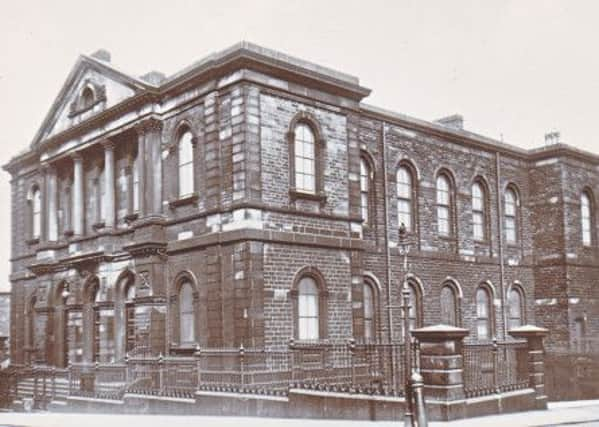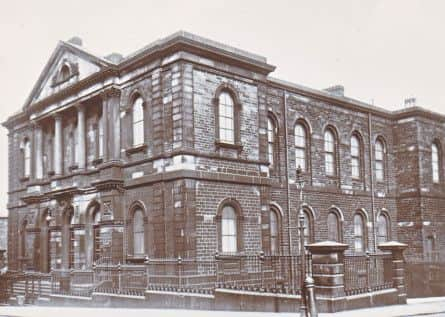Days of the great Non-Conformist chapels in Burnley


All that said, some Non-conformist places of worship contrived to look more like churches than chapels. We had a good example in Burnley only the tower of which remains. I refer to the Wesleyan Methodist Church in Manchester Road. The image here only shows part of the building but you can see it is more like an Anglican church than might be expected. Here you see the church (not chapel) on the day it was opened, October 26th, 1905. As you can see, it was a typical autumn day. The retailers of umbrellas had enjoyed a good day. Just about everyone has one and is making conspicuous use of it. Only one or two individuals are without protection from the rain.
Notice the noticeboards on the left. The top one seems to be something of an oversight as it announces this is the site of the Wesleyan Church though it is clearly completed in this picture.
Advertisement
Hide AdAdvertisement
Hide AdUnderneath, there are six clergymen named who are lined up to take part in the “Opening and Dedication Services”. They include the Rev. C.H. Kelly, Chairman of the Wesleyan Conference, but he and his colleagues give precedence to “Miss Barnes of Southport” who may have been the daughter of Burnley cotton spinner and manufacturer John Barnes, who had Bankfield Mill, and who lived at Reedley Hall. He had been Mayor of Burnley in 1872.


A few words about Charles H. Kelly, who was born in Salford in 1833. He was twice chairman of the conference, in 1889 and 1905. He was one of the most influential Wesleyans of his day and it was something of a coup to get him to Burnley. These days he is remembered as the author of a number of exceedingly well written books but he was also the publisher for his denomination and his name appears on a great number of titles published by them. He died in 1911.
This Wesleyan Methodist Church was built to impress. It was designed by Burnley’s most important architect of the late 19th and early 20th Centuries, William Waddington, who had a preference for the Gothic style of architecture. In addition, Waddington lived in the large house directly opposite the church and I suspect he was quite pleased to see the building every morning.
You will see a number of the Non-conformist buildings we feature today are not of the Gothic style. The Gothic architecture of Victorian times was inspired by the great churches and cathedrals of the Middle Ages. These buildings usually had towers and spires and complicated fenestration (windows) together with beautiful stained glass. The style was adopted by the Church of England from the late 1830s and, to a lesser extent, by the Catholics when they were allowed to build their own churches after 1850.
Advertisement
Hide AdAdvertisement
Hide AdThe Non-conformists (Methodists, Wesleyans, Baptists, Congregationalists etc) usually built in the Classical style. These buildings were inspired by the great temples and palaces of Greece and Ancient Rome. Their most significant features include pillars and pilasters mounted by huge pedestals and in Burnley we once had an outstanding example in Fulledge Chapel in Todmorden Road.
Many of you will recall the huge black pillars on the front elevation but the rather plain side and rear elevations.
Notice that, though the building was magnificent, Fulledge was merely a chapel. Most Non-conformist places of worship were chapels rather than churches even though they, like Fulledge and Brunswick, were huge and mightily impressive buildings.
The latter has also succumbed, not to fire as was the case with Fulledge, but to demolition. We show the reproduction of a card of Hanover Methodist Free Church, Old Hall Street. It is not of the building itself but of includes a banner which contains an image of the church which, as you can see, is built in the Classical style.
Advertisement
Hide AdAdvertisement
Hide AdIn another of our selections, you see another Classical building in Colne Road. This is the still extant, though not now used for Christian worship, Burnley Lane, formerly Ebenezer, Chapel another of the great Non-conformist buildings of Burnley.
The gradual disappearance of the town’s great Non-conformist chapels and churches is one of the tragedies of recent years.
At one time just about everyone spent part of Sunday at a place of worship. This is no longer the case and, one by one, we have lost far too many of these buildings. Fulledge and Brunswick have gone as has most of the Wesleyan Methodist Church in Manchester Road. Of this latter only the tower and spire remains.
The same applies to another impressive building, Colne Road Wesleyan Methodist Church only the Sunday School of which survives today. This was another building designed by William Waddington and though not as impressive as the Manchester Road building it still managed to dominate part of Colne Road.
Advertisement
Hide AdAdvertisement
Hide AdSo, let us have a look at some of these great buildings. I have used only postcard images today but the Briercliffe Society has photographic views of a number of other Burnley chapels which I might bring together for another article in this series.